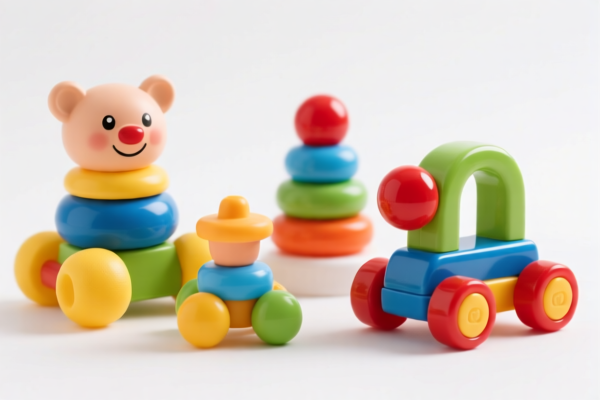| HS Code | Official Doc | Tariff Rate | Origin | Destination | Effective Date |
|---|---|---|---|---|---|
| 9503000071 | Doc | 30.0% | CN | US | 2025-05-12 |
| 9503000073 | Doc | 30.0% | CN | US | 2025-05-12 |
| 3924104000 | Doc | 33.4% | CN | US | 2025-05-12 |
| 3924905650 | Doc | 40.9% | CN | US | 2025-05-12 |




Building Blocks Toys
Building blocks are toys consisting of small, often colorful, pieces that children can connect to construct various structures. They are recognized for their educational value, promoting spatial reasoning, creativity, and problem-solving skills.
Material
- Plastic: The most common material, typically Acrylonitrile Butadiene Styrene (ABS) plastic, known for its durability, impact resistance, and ability to hold color. Other plastics like polypropylene are also used.
- Wood: Traditional building blocks are made from wood, often softwoods like pine or beech. These are generally less colorful than plastic blocks but offer a classic aesthetic and tactile experience.
- Foam: Softer, larger blocks made from foam are designed for younger children, prioritizing safety and ease of handling.
- Cardboard: Environmentally friendly option, often used for larger-scale construction sets.
- Metal: Less common, but metal building blocks offer a unique construction experience and structural stability.
Purpose & Function
- Educational: Develops spatial reasoning, hand-eye coordination, fine motor skills, problem-solving abilities, and mathematical concepts (shape, size, counting).
- Creative Expression: Encourages imagination, design skills, and storytelling through open-ended building possibilities.
- Cognitive Development: Fosters logical thinking, planning, and experimentation.
- Social Interaction: Promotes collaboration and communication when children build together.
Usage Scenarios
- Independent Play: Children can explore their creativity and build structures individually.
- Group Play: Collaborative building projects encourage teamwork and communication.
- Educational Settings: Used in preschools, kindergartens, and classrooms to support learning and development.
- Therapeutic Play: Can be used in occupational therapy to improve motor skills and coordination.
- Hobby & Collection: More complex building block sets are popular among adults as a hobby and collecting activity.
Common Types
- Large Building Blocks: Designed for toddlers and preschoolers, featuring larger pieces for easy handling and safety. (e.g., Mega Bloks)
- Interlocking Bricks: The most popular type, characterized by studs and tubes that allow for secure connections. (e.g., LEGO)
- Wooden Blocks: Classic, non-interlocking blocks often used for stacking and creating simple structures.
- Magnetic Blocks: Utilize magnets for easy connection and unique building possibilities. (e.g., Magna-Tiles)
- Construction Sets: Themed sets with specific instructions for building particular models (e.g., LEGO Technic, LEGO Architecture).
- Soft Blocks: Foam or fabric blocks designed for infants and toddlers, prioritizing safety and tactile exploration.
- Art Blocks: Blocks designed for creating mosaics or 2D art projects.
Building blocks toys fall under the category of toys, specifically those encompassing tricycles, scooters, pedal cars and similar wheeled toys; dolls’ carriages; dolls, other toys; reduced-scale (“scaleˮ) models and similar recreational models, working or not; puzzles of all kinds; parts and accessories thereof. The following HS codes are applicable based on the provided information:
- 9503000071: This HS code covers Tricycles, scooters, pedal cars and similar wheeled toys; dolls’ carriages; dolls, other toys; reduced-scale (“scaleˮ) models and similar recreational models, working or not; puzzles of all kinds; parts and accessories thereof, categorized as “Children’s products” as defined in 15 U.S.C. § 2052, specifically labeled or determined by the importer as intended for use by persons under 3 years of age. The total tax rate is 30.0%, comprising a base tariff of 0.0%, a zero additional tariff, and a 30.0% additional tariff effective April 2, 2025.
- 9503000073: This HS code also covers Tricycles, scooters, pedal cars and similar wheeled toys; dolls’ carriages; dolls, other toys; reduced-scale (“scaleˮ) models and similar recreational models, working or not; puzzles of all kinds; parts and accessories thereof, categorized as “Children’s products” as defined in 15 U.S.C. § 2052, but is for items labeled or determined by the importer as intended for use by persons aged 3 to 12 years. The total tax rate is 30.0%, consisting of a base tariff of 0.0%, a zero additional tariff, and a 30.0% additional tariff effective April 2, 2025.
Important Note: When declaring building blocks toys, it is crucial to accurately determine the intended age group of the users (under 3 years or 3 to 12 years) as this directly impacts the applicable HS code (9503000071 or 9503000073) and consequently, the tariff rate. Both HS codes are subject to a 30.0% additional tariff starting April 2, 2025.
Customer Reviews
No reviews yet.